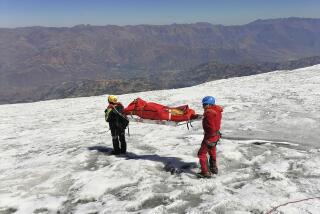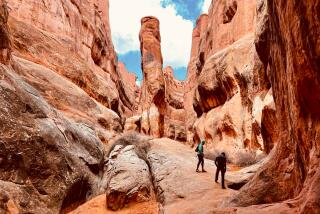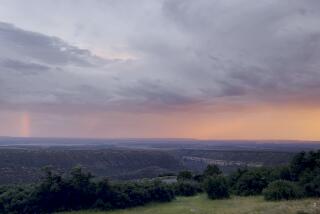‘The Middle of the Middle of Nowhere’ : Finding birds, wild blueberries, glaciers and even a polar bear in an Arctic park
PANGNIRTUNG, Canada — A pair of snow geese, glistening white except for their black wingtips, glide effortlessly above me, the sound of their calls drowned out by the rush of gray glacial water that is numbing my legs to mid-thigh. Supporting myself with two ski poles, I take another unsteady step across the river with feet that feel like blocks of ice. Boulders shift underfoot in the raging current and, pushed on by yet another rush of adrenaline, I take one more step and am finally on the sandbar on the far side of the wide, braided Owl River.
After quickly replacing wool socks and hiking boots, a short walk takes me to the shores of Summit Lake. Surrounded by soaring towers of black rock rising to 8,000 feet in great craggy outcrops sculpted by massive glaciers, this is the halfway point in my hike. The glaciers, long white fingers of the Penny Icecap, are remnants of the last Ice Age, and the reason that this spectacular valley was named Auyuittuq--”the land that never melts”--by the native Inuit people.
I am in the central Arctic with a friend, a Montreal biochemist named Philip Kibler, to hike through Auyuittuq (pronounced ah-you-ee-tuk), an awesome and seldom traveled region of fiords and glaciers that in 1972 became the first national park established in the Canadian Arctic. We will be hiking for 10 days across tundra and a jumbled moraine of countless glaciers, crossing rivers and streams on a trek that will take us across the Arctic Circle.
The hike is not difficult--the total elevation gain is only 500 feet--but the footing can be difficult, and the weather can change abruptly. Even though we chose midsummer for our trip, a snowfall is not unlikely. The attractions are the beauty of the stark landscape and the remoteness that allows you the solitude of traveling for days without seeing another soul. It was only a few days earlier, during a sweltering August in Montreal, that Philip and I boarded a plane and flew almost 1,300 miles due north to the town of Iqaluit (formerly Frobisher Bay) on Baffin Island.
Our stop in Iqaluit was just long enough to head to the Toonoonik Hotel dining room for a caribou burger, which tastes like a delicious cross between beef and venison and is one of the most popular “country foods”--native hunted meats--in the Arctic. Iqaluit, a rough-and-tumble frontier town of 3,600 people, is the biggest settlement in the eastern Northwest Territories and will become the capital of the new, Inuit-run territory of Nunavut in 1999.
Auyuittuq National Park is a 2,200-square-mile reserve that straddles the Cumberland Peninsula to the east of Iqaluit. Since the park is generally accessible only by water, the most popular itinerary is to take the two-hour boat trip from the town of Pangnirtung, on the western end of the park, up stunning Pangnirtung Fiord to the trail head at the Overlord Warden Station. From there the trail follows the Weasel River to Summit Lake, a distance of about 30 miles through alpine scenery of steep mountains, glaciers and wild mountain streams. Most hikers then return via the same route; the trip takes about a week, or longer if you explore glaciers on side trails en route.
But you can continue over the summit for another 30 miles to emerge on Baffin Island’s east coast, where a six-hour boat trip takes you to Broughton Island. We had decided to walk the entire length of the trail. Since Broughton Island’s harbor is frequently choked with ice--even in the middle of summer--we decided to start our hike in there and hike back to warmer Pangnirtung.
From Iqaluit, an hourlong prop plane flight took us to Broughton Island, where the lone National Park ranger there issued us a permit ($100 for three or more days) and a heavy-duty yellow garbage bag. He suggested that if we camped near the shelters spaced an easy day’s hike apart, we should place our food and garbage in the critter-proof container alongside. “But as far as polar bears are concerned, they are rarely seen in the park,” he assured us. “They prefer to be out on the ice where there is food like seals.”
*
The following morning, while waiting for Pauloosie Kooneeliusie, a local outfitter we had hired, to free up his boat from a crush of ice chunks, we had breakfast in Broughton’s only coffee shop.
“Want to see a polar bear?” an Inuit man asked casually as he stepped into the tiny cafe. Grabbing gloves and hats we flew outside and joined a crowd that must have included most of the town’s 450 residents. A Royal Canadian Mounted Police officer was there, as well as the park ranger holding a rifle. And the bear.
The great shaggy beast on the shore about 100 yards away from us was trying to make its way to one of the floating ice chunks that were drifting past in the current. Once on the ice again, the bear rolled in the snow, reared up on its hind legs and sniffed the air. We spent the next two hours sipping coffee and watching through the coffee shop window as the bear slowly made its way from one ice chunk to another as the radio played a Cowboy Junkies tune that echoed my sentiments about our upcoming trek: “. . . my heart wants to go, but my soul’s full of fear.”
It wasn’t until the next morning that the weather and ice finally cleared, and we made our way in bright sunshine up the long narrow tongue of North Pangnirtung Fiord. On board were a couple from Vancouver who were also hiking, as well as Pauloosie’s wife, Kilabuk, and a gathering of their children and grandchildren. It was a fun day’s outing for everyone.
By late afternoon we had waved the boat goodbye and set off hiking from the bright orange warden station at the head of the fiord, making our way alongside the broad delta of the Owl River. Even someone as geographically challenged as I am could find my way along this route: The first half of the hike follows the broad Owl River upstream to Summit Lake. From there we stay alongside the Weasel River as it flows downstream.
The Arctic hiking season is generally restricted to July and August. Hiking on the spongy tundra, a knee-high world of miniature willows and hearty wildflowers, is tiring, like trekking through a bed of deep feather pillows. So, where possible, we walked along the sandy riverbank in balmy temperatures of 65 degrees, an Arctic heat wave.
We set up camp on a hillock at about 10 p.m., just as the last rays of sunshine lighted up the tips of the mountain peaks above us. Philip grabbed the water bottles to fill them in the stream nearby, but came running back moments later breathless, pointing at the sky behind the tent. Above the peaks the sky had been transformed with green curtains of northern lights tinged with red, a brilliant display that shimmered and shifted for the next half-hour.
I awoke with the sunrise, stretched and readied to get up. I glanced at my watch: 2 a.m.! Above the Arctic Circle, nights are short this time of year.
We awoke again to a midday sun at 8 a.m. to the calls of flocks of Canada geese. A couple of snow buntings, small Arctic birds, hopped about as we made breakfast. The Owl River Valley is wide and open, a huge U-shaped hanging valley flanked on either side by glacier-capped mountains. At first glance it seemed there was little life in this stark landscape, but looking closer we saw that every nook and cranny was well occupied, especially in shelters from the winds that often funnel through this valley at high speeds.
Lemmings scurried into ground holes, and everywhere we saw the tracks of shy Arctic foxes. Sometimes we saw lichen-covered antlers from caribou that once wandered through this area but were hunted out several decades ago.
When we finally reached the orange emergency buildings at June Shelter, three Inuit park rangers on routine patrol were just getting ready to leave. Sitting in the radiant sunshine, we read the logbook: “Tussock tundra miles are three times longer than ordinary miles,” rightly noted someone from Davis, Calif. And under an entry dated Aug. 11, 1988, a group from Genoa, Italy, wrote of their trip, “A raging blizzard slowed our pace. . . .”
The days were long and leisurely. We quickly teamed to give a wide berth to the clusters of white puffs of Arctic cotton, a kind of grass that signaled boggy ground where we sank to our knees. Roaring waterfalls echoed off valley walls, and the occasional rock fall that left dust and debris hanging in the air reminded us to be careful in choosing our campsite at night.
Along the hillsides, the Arctic blueberries were ripe, and we filled our bowls with the delicious sweet fruit. One morning we saw a snowy owl sitting motionless on a rock. With every mile the number of glaciers in our field of view increased--until Philip, frustrated, said: “In most places you drive for hours and then hike to see a single glacier; here there are so many I can’t pinpoint where we are on the map!” The blissful warm weather lasted for four days as we made our way toward Summit Lake, whose peaks finally came into view.
*
On the fourth day we reached the top of the Owl Valley, the point where we had to cross the Owl River. A scramble up jagged moraine and we were alongside Summit Lake, where the scenery changed in an instant and we were surrounded with steep, soaring peaks. Making our way around the lake shore, we followed trail markers called inukshuks, piles of rock cleverly stacked to look like people. Philip checked the map. “We’re in the middle of the middle of nowhere.”
Crossing over Akshayuk Pass, we were exactly halfway through our hike.
It grew cloudy and windy as we reached the end of the lake and strapped ourselves into a chair-like contraption made of rebar and chains at the edge of the Weasel River. I held my breath, placed my faith in the National Park Service and launched myself over the roaring white water. I was flooded with relief to feel solid ground on the far side.
Steep cliffs soared skyward. One, Mt. Thor, rises a mile straight up in a sheer wall above the river, the tallest cliff in the world. The well-worn trail from the summit was like a highway after making our way along the Owl.
Wind was our constant companion on this second stretch, and it was howling in the dark at midnight when we finally reached the marker signaling we had crossed the Arctic Circle. Five days after we had left the summit, I used the high-frequency radio at Windy Lake Shelter to call for boat transportation the next day from Overlord Warden Station, at the fiord’s edge, out to Pangnirtung.
At Pangnirtung, we pitched our tent at the local campground and made our way to the town’s only hotel, Auyuittuq Lodge, where we enjoyed the bliss of a long hot shower to wash off days of grime and sweat ($16 plus tax, and worth every penny!).
That evening, after having secured a fresh Arctic char from the fish processing plant, we concocted our own bouillabaisse in front of our tent. Throughout dinner a parade of locals came by for a chat or to sell handicrafts they had made, everything from stone carvings to kamiks, sealskin boots. I settled on a pair of walrus tusk ivory inukshuk earrings. There was something about those human-shaped trail markers that would always remind me of this trip: little stone men keeping vigil on a trail through a remote, magical landscape.
(BEGIN TEXT OF INFOBOX / INFOGRAPHIC)
GUIDEBOOK: Canada’s Arctic Outback
Getting there: Traveling to this remote part of the world is expensive. Visitors must first connect to Montreal (Air Canada or Continental) or Ottawa (Air Canada), then to daily First Air flights from either city to Iqaluit on Baffin Island; round-trip, advance-purchase fare is about $950, including taxes.
Where to stay: In Iqaluit, one of the best of several hotels is the Discovery Lodge (telephone [819] 979-4433, fax [819] 979-6591); rates$107-$142 per person. For a B&B;, Accommodations by the Sea (tel. [819] 979-0219 or [819] 979-6074, fax [819] 979-1830) is an excellent choice at $84 for a double room. On Broughton Island, the only hotel is the Tulugak (tel. [819] 927-8874, fax [819] 927-8124), a basic hostel overlooking Broughton Harbor; rates are $142 per person, including three meals;$96 without meals. There is also a campsite, but ask about the polar bear situation before setting up your tent.
In Pangnirtung, the Auyuittuq Lodge (tel. [819] 473-8955, fax [819] 473-8611) has shared bathrooms; rates per person are $142 with meals, $92 without. The minimal but free Pisuktinu Tungavik Territorial Campground is on the outskirts of town.
Outfitters: In Pangnirtung, one-way boat fares from Pangnirtung or Overlord Warden Station are $57 per person (tel. [819] 473-8737 for advance arrangements). North Winds Arctic Adventures (tel. [819] 979-0551, fax [819] 979-0573) offers guided hikes through Auyuittuq National Park for those who don’t want to undertake the trek on their own. A 14-day trip costs $2,000 (all supplies--tents, sleeping bags, meals--included) per person.
For more information: Auyuittuq National Park Reserve, Parks Canada, P.O. Box 353, Pangnirtung, Northwest Territories X0A0R0 Canada, tel. (819) 473-8828, fax (819) 473-8612; Nunavut Tourism, tel. (800) 491-7910; or the Canadian Consulate, Tourist Information, 550 S. Hope St., Los Angeles, CA 90071; tel. (213) 346-2700, fax (213) 346-2767.
More to Read
Sign up for The Wild
We’ll help you find the best places to hike, bike and run, as well as the perfect silent spots for meditation and yoga.
You may occasionally receive promotional content from the Los Angeles Times.






